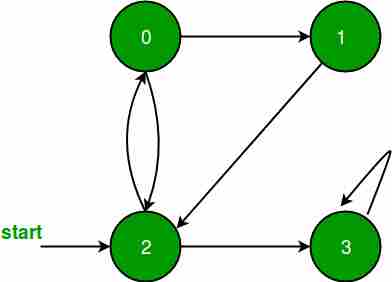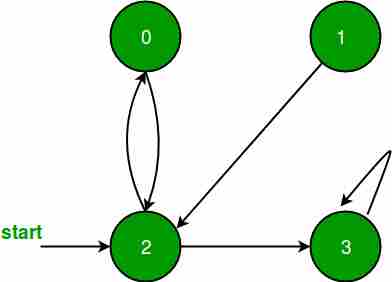以前 邮递 ,只对特定顶点执行BFS,即假设所有顶点都可以从起始顶点到达。但是,对于断开连接的图或从所有顶点都无法到达的任何顶点,之前的实现不会给出所需的输出,因此在本文中,BFS中进行了修改。
null
 所有顶点都是可到达的。所以,对于上面的图来说很简单 BFS 会有用的。
所有顶点都是可到达的。所以,对于上面的图来说很简单 BFS 会有用的。
 如上图所示,所有顶点都无法到达顶点1,所以简单的BFS不适用于它。
如上图所示,所有顶点都无法到达顶点1,所以简单的BFS不适用于它。
Just to modify BFS, perform simple BFS from each unvisited vertex of given graph.
C++
// C++ implementation of modified BFS #include<bits/stdc++.h> using namespace std; // A utility function to add an edge in an // undirected graph. void addEdge(vector< int > adj[], int u, int v) { adj[u].push_back(v); } // A utility function to do BFS of graph // from a given vertex u. void BFSUtil( int u, vector< int > adj[], vector< bool > &visited) { // Create a queue for BFS list< int > q; // Mark the current node as visited and enqueue it visited[u] = true ; q.push_back(u); // 'i' will be used to get all adjacent vertices 4 // of a vertex list<int>::iterator i; while (!q.empty()) { // Dequeue a vertex from queue and print it u = q.front(); cout << u << " " ; q.pop_front(); // Get all adjacent vertices of the dequeued // vertex s. If an adjacent has not been visited, // then mark it visited and enqueue it for ( int i = 0; i != adj[u].size(); ++i) { if (!visited[adj[u][i]]) { visited[adj[u][i]] = true ; q.push_back(adj[u][i]); } } } } // This function does BFSUtil() for all // unvisited vertices. void BFS(vector< int > adj[], int V) { vector< bool > visited(V, false ); for ( int u=0; u<V; u++) if (visited[u] == false ) BFSUtil(u, adj, visited); } // Driver code int main() { int V = 5; vector< int > adj[V]; addEdge(adj, 0, 4); addEdge(adj, 1, 2); addEdge(adj, 1, 3); addEdge(adj, 1, 4); addEdge(adj, 2, 3); addEdge(adj, 3, 4); BFS(adj, V); return 0; } |
JAVA
// Java implementation of modified BFS import java.util.*; public class graph { //Implementing graph using HashMap static HashMap<Integer,LinkedList<Integer>> graph= new HashMap<>(); //utility function to add edge in an undirected graph public static void addEdge( int a, int b) { if (graph.containsKey(a)) { LinkedList<Integer> l=graph.get(a); l.add(b); graph.put(a,l); } else { LinkedList<Integer> l= new LinkedList<>(); l.add(b); graph.put(a,l); } } //Helper function for BFS public static void bfshelp( int s,ArrayList<Boolean> visited) { // Create a queue for BFS LinkedList<Integer> q= new LinkedList<>(); // Mark the current node as visited and enqueue it q.add(s); visited.set(s, true ); while (!q.isEmpty()) { // Dequeue a vertex from queue and print it int f=q.poll(); System.out.print(f+ " " ); //Check whether the current node is //connected to any other node or not if (graph.containsKey(f)) { Iterator<Integer> i=graph.get(f).listIterator(); // Get all adjacent vertices of the dequeued // vertex f. If an adjacent has not been visited, // then mark it visited and enqueue it while (i.hasNext()) { int n=i.next(); if (!visited.get(n)) { visited.set(n, true ); q.add(n); } } } } } //BFS function to check each node public static void bfs( int vertex) { ArrayList<Boolean> visited= new ArrayList<Boolean>(); //Marking each node as unvisited for ( int i= 0 ;i<vertex;i++) { visited.add(i, false ); } for ( int i= 0 ;i<vertex;i++) { //Checking whether the node is visited or not if (!visited.get(i)) { bfshelp(i,visited); } } } //Driver Code-The main function public static void main(String[] args) { int v= 5 ; addEdge( 0 , 4 ); addEdge( 1 , 2 ); addEdge( 1 , 3 ); addEdge( 1 , 4 ); addEdge( 2 , 3 ); addEdge( 3 , 4 ); bfs(v); } } |
Python3
# Python3 implementation of modified BFS import queue # A utility function to add an edge # in an undirected graph. def addEdge(adj, u, v): adj[u].append(v) # A utility function to do BFS of # graph from a given vertex u. def BFSUtil(u, adj, visited): # Create a queue for BFS q = queue.Queue() # Mark the current node as visited # and enqueue it visited[u] = True q.put(u) # 'i' will be used to get all adjacent # vertices 4 of a vertex list<int>::iterator i while ( not q.empty()): # Dequeue a vertex from queue # and print it u = q.queue[ 0 ] print (u, end = " " ) q.get() # Get all adjacent vertices of the # dequeued vertex s. If an adjacent # has not been visited, then mark # it visited and enqueue it i = 0 while i ! = len (adj[u]): if ( not visited[adj[u][i]]): visited[adj[u][i]] = True q.put(adj[u][i]) i + = 1 # This function does BFSUtil() for all # unvisited vertices. def BFS(adj, V): visited = [ False ] * V for u in range (V): if (visited[u] = = False ): BFSUtil(u, adj, visited) # Driver code if __name__ = = '__main__' : V = 5 adj = [[] for i in range (V)] addEdge(adj, 0 , 4 ) addEdge(adj, 1 , 2 ) addEdge(adj, 1 , 3 ) addEdge(adj, 1 , 4 ) addEdge(adj, 2 , 3 ) addEdge(adj, 3 , 4 ) BFS(adj, V) # This code is contributed by PranchalK |
C#
// C# implementation of modified BFS using System; using System.Collections.Generic; class Graph { //Implementing graph using Dictionary static Dictionary< int ,List< int >> graph = new Dictionary< int ,List< int >>(); //utility function to add edge in an undirected graph public static void addEdge( int a, int b) { if (graph.ContainsKey(a)) { List< int > l = graph[a]; l.Add(b); if (graph.ContainsKey(a)) graph[a] = l; else graph.Add(a,l); } else { List< int > l = new List< int >(); l.Add(b); graph.Add(a, l); } } // Helper function for BFS public static void bfshelp( int s, List<Boolean> visited) { // Create a queue for BFS List< int > q = new List< int >(); // Mark the current node as visited and enqueue it q.Add(s); visited.RemoveAt(s); visited.Insert(s, true ); while (q.Count != 0) { // Dequeue a vertex from queue and print it int f = q[0]; q.RemoveAt(0); Console.Write(f + " " ); //Check whether the current node is //connected to any other node or not if (graph.ContainsKey(f)) { // Get all adjacent vertices of the dequeued // vertex f. If an adjacent has not been visited, // then mark it visited and enqueue it foreach ( int iN in graph[f]) { int n = iN; if (!visited[n]) { visited.RemoveAt(n); visited.Insert(n, true ); q.Add(n); } } } } } // BFS function to check each node public static void bfs( int vertex) { List<Boolean> visited = new List<Boolean>(); // Marking each node as unvisited for ( int i = 0; i < vertex; i++) { visited.Insert(i, false ); } for ( int i = 0; i < vertex; i++) { // Checking whether the node is visited or not if (!visited[i]) { bfshelp(i, visited); } } } // Driver Code public static void Main(String[] args) { int v = 5; addEdge(0, 4); addEdge(1, 2); addEdge(1, 3); addEdge(1, 4); addEdge(2, 3); addEdge(3, 4); bfs(v); } } // This code is contributed by Rajput-Ji |
输出:
0 4 1 2 3
本文由 萨希尔·查布拉(阿克库) .如果你喜欢GeekSforgek,并想贡献自己的力量,你也可以使用 写极客。组织 或者把你的文章寄去评论-team@geeksforgeeks.org.看到你的文章出现在Geeksforgeks主页上,并帮助其他极客。
如果您发现任何不正确的地方,或者您想分享有关上述主题的更多信息,请写下评论。
© 版权声明
文章版权归作者所有,未经允许请勿转载。
THE END


![关于”PostgreSQL错误:关系[表]不存在“问题的原因和解决方案-yiteyi-C++库](https://www.yiteyi.com/wp-content/themes/zibll/img/thumbnail.svg)



